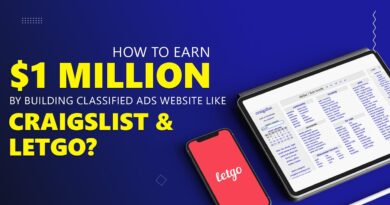3 Things Amazon Gurus DON'T Tell You About Selling on Amazon FBA…
There are 3 things that “Amazon gurus” don’t tell you about selling on Amazon…
►► EBOOK: How 6-Figure Stores Earn $10k/month – http://wholesaleted.com/4-step
►► How to Launch Your First Amazon Product – https://youtu.be/JPwscpE-53g
***OTHER LINKS REFERENCED IN VIDEO***
►► 5 Mistakes New Importers Make: https://www.youtube.com/watch?v=tb7PNEU1r5w
►► Seller Tradecraft: https://www.youtube.com/channel/UCPHntYYv-dwbTP-g-y4RYsg
Yes, we all know that Amazon gurus love to talk about spending money on fancy cars (and buying Lamborghinis)… but what about the dark sides to the business that they don’t talk about? Here is the truth about selling on Amazon.
#1: Income Screenshots are REVENUE, NOT Profit
When you see an income screenshot posted by someone, remember that this is the total amount in SALES that they have made. This is not the profit that they have earned. If someone posts that they have made $10,000 in sales last month, this does not take into account the expenses paid to make those sales (like purchasing inventory, the costs of shipping, Amazon FBA fees or costs spent on marketing).
Usually, if someone is making consistent, monthly sales, this is a good indicator that they are making a profit. How much profit you can’t know – but in the industry, the yardstick that most people aim for is to make a 30% profit margin on Amazon FBA private label items.
However, while most people do usually profit from their sales, there is one big exception to this: and that is the first month in business.
When you launch a product on Amazon, to be able to make a large volume of sales, you need to run a launch campaign and use marketing techniques to generate as many sales as possible. To do this, sellers do the following things:
* Send out discount coupons using services like ZonJump.
* Invest money into Amazon PPC ads.
* Discount the price of the item (price competition).
All of these marketing techniques can be very expensive, and they eat into profits. That 30% profit margin is based off customers finding your item organically using the search engine – NOT from people buying it from a discount coupon/from a PPC ad. This means it is very common for new Amazon products to at best break even or, more likely, LOSE money in their first month.
However: it’s worth it. By investing into a launch campaign, you can create a huge volume of sales and push your item to the top of the Amazon search results and make passive, on-going sales into the future.
#2: To Make a Lot of Money, You NEED A LOT OF MONEY!
Unlike dropshipping where you can get started for $500, with Amazon FBA private labeling you’re going to need a lot of money. As Sarah explains in the video, to launch a product that makes $10,000/month in sales, you will need at least $9,000 just for the inventory alone, and that doesn’t include the costs of marketing, tools etc.
However, you don’t need $9,000 to launch a product on Amazon. You can get started with smaller budgets like $3,000, but if you do, you will need to be realistic about the types of products that you choose to sell. Look to sell a product that is on average doing a low monthly sales volume (a good number to look for is around 100 units a month).
Another advantage of these products as well is that they usually have less competition, as most Amazon FBA private labelers want to go after higher volume items. This means you’ll need to spend less money on marketing when launching your product.
#3: It’s Very Easy to Go Into Debt When Running an Amazon FBA Business
When you are running an Amazon FBA business, it is very easy to go into a lot of debt. Why? Well, it’s because your expenses are very high. It’s very expensive to purchase inventory. Most of the money that flows into the business is going to go towards paying for expenses. This means that you need to be careful that you manage that cash in it.
A common trap that Amazon private labelers fall for, especially high-level Amazon businesses, is that they try and expand too quickly. They realize that if they spend money purchasing MORE items and MORE inventory, that they can sell it and make MORE money. And so they use all of the cash they have, and max out their debt, in an attempt to purchase as many items as possible.
And this is all well and good… until they get an unexpected bill, like a tax bill. Normally they could pay it, but because they’ve tied up all of their cash and debt in inventory, they don’t have any money left to pay the bill. And even though they will have the money to pay for it tomorrow, it doesn’t matter, because it needs to be paid for TODAY.
But this can be easily avoided if you manage your cash flow correctly. We strongly recommend you follow the Profit First system!
source



